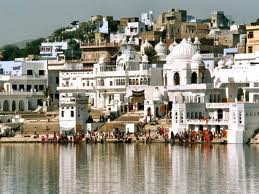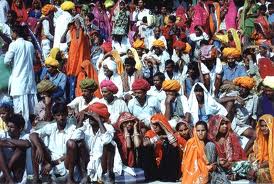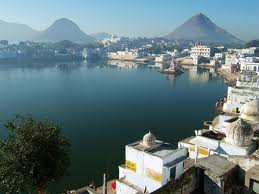|
Pushkar for a devout Hindu Pushkar is
a very importa nt pilgrim centre, for one visit to this holy place in a lifetime
is highly prescribed. Brahma forms the great Hindu trilogy of Brahma, Vishnu and
Shiva, each symbolising the lifecycle of birth, preservation and destruction.
Brahma the creator is depicted as of four bearded heads and four hands each
holding a book of Vedas (knowledge). His vehicle is the swan and his consort is
Savitri. According to the legend Pushkar means a pond created by flower, was
formed when Brahma dropped a lotus flower on the earth to determine a place for
his yagna, a holy sacrifice. The story goes that Brahma wanted to perform the
yagna at the most auspicious time but his consort Savitri whose presence at the
yagna was vital for its performance kept him waiting. Irritated by this Brahma
married Gayatri, a milkmaid and installed her instead. Savitri on seeing someone
else in her place was infuriated and cursed Brahma that he would be forgotten by
people on earth and never worshiped. She relented on pleas from other Gods that
he could only be worshiped in Pushkar, hence there are no Brahma Temples
elsewhere nt pilgrim centre, for one visit to this holy place in a lifetime
is highly prescribed. Brahma forms the great Hindu trilogy of Brahma, Vishnu and
Shiva, each symbolising the lifecycle of birth, preservation and destruction.
Brahma the creator is depicted as of four bearded heads and four hands each
holding a book of Vedas (knowledge). His vehicle is the swan and his consort is
Savitri. According to the legend Pushkar means a pond created by flower, was
formed when Brahma dropped a lotus flower on the earth to determine a place for
his yagna, a holy sacrifice. The story goes that Brahma wanted to perform the
yagna at the most auspicious time but his consort Savitri whose presence at the
yagna was vital for its performance kept him waiting. Irritated by this Brahma
married Gayatri, a milkmaid and installed her instead. Savitri on seeing someone
else in her place was infuriated and cursed Brahma that he would be forgotten by
people on earth and never worshiped. She relented on pleas from other Gods that
he could only be worshiped in Pushkar, hence there are no Brahma Temples
elsewhere
Fair & Festivals
Pushkar Fair
The well-known and marked with largest partici pation of all the festivals of
Rajasthan, Pushkar is an important pilgrimage as well as the venue of a mammoth
cattle fair. Bazaars, auctions, music and sports are highlight of this event. pation of all the festivals of
Rajasthan, Pushkar is an important pilgrimage as well as the venue of a mammoth
cattle fair. Bazaars, auctions, music and sports are highlight of this event.
The Pushkar Fair, a major tourist attraction draws people from all over the
globe to the ancient and secluded environment of Pushkar town. Pushkar Fair is
perhaps the largest cattle fair in the world. Rajasthan which is enriched by
cattle wealth is the home to many recognized breeds of cattle.
The world-famous Fair is held in the sacred and peaceful town of Pushkar, 11 kms.
north-west of Ajmer. It transforms into a spectacular fair ground for twelve
days during the month of Kartik (Oct-Nov).
Rajasthan's most famous fair, it brings together camel traders, pilgrims
visitors, and those who're here simply to participate in one of the season's
most colorful social events, Besides tented camps, there are hundreds of shops
selling everything from handicrafts to spices, foodstuff and jewellery, for
visitors a number of activities are also arranged but most simply with to stay
within fair grounds to watch the fascinating Rajasthani village metamorphose
before their eyes.
Pushkar History
Historically, Pushkar always had great strategic importance and was sacked by
Mahumud of Ghazni on one of his periodic forays from Afghanistan. Later it
becam e a favorite residence of the great Moghula. One of the first contacts
between the Moghula and the British occurred in Pushkar when Sir Thomas Roe met
with Jahangir here in 1616. The city was subsequently taken by the Scindias and,
in 1818, it was handed over to the British, becoming one of the few places in
Rajasthan controlled directly by British rather than being part of a princely
state. e a favorite residence of the great Moghula. One of the first contacts
between the Moghula and the British occurred in Pushkar when Sir Thomas Roe met
with Jahangir here in 1616. The city was subsequently taken by the Scindias and,
in 1818, it was handed over to the British, becoming one of the few places in
Rajasthan controlled directly by British rather than being part of a princely
state.
Places to see
Temples
Pushkar boasts temples, through few are as ancient pilgrimage site many were
destroyed by Aurangzeb and subsequently rebuilt. The most famous is what is said
to be the only temple in India dedicated to Brahma. It's marked by a red spire
and over the entrance gateway is the Hans, or goose symbol, of Brahma, who is
said to have personally chosen Pushkar as its site. The Rangji Temple chosen is
also important.
The one - hour trek up to the hilltop temple overlooking the lake is best made
early in the morning; the view is magnificent.
Ghats Numerous ghats run down to the lake, and pilgrims are constantly bathing
in the lake's holy waters. If you wish to join them, do it with respect - remove
your shoes, don't smoke and don't take photographs. This is not Varanasi and the
pilgrims here can be very touchy about insensitive instruction by non - Hindus. |